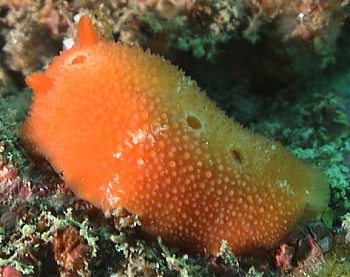
Aldisa sanguinea
(Cooper, 1873)
Order: NUDIBRANCHIA
Suborder: DORIDINA
Superfamily: EUDORIDOIDEA
Family: Dorididae
DISTRIBUTION
Oregon to Gulf of California, Mexico.
PHOTO
North Monastery Beach, 10m, Carmel, California, USA. Approx 25mm long. Photo: Clinton Bauder.
Red with one or two dark spots in the dorsal midline which look like the oscula (exhalant pores) of sponges. There is sometimes traces of a light brown or cream transverse streak on each side the mantle about midway. Grows to about 25mm long.
Found from the intertidal to about 10m. The orange egg ribbons, form a 4 whorl spiral and a laid on their sponge food. It is reported to feed on the orange sponges Ophlitaspongia pennata and Hymendesmia brepha.
Reference:
• Millen, S. V. & Gosliner, T. M. 1985. Four new species of dorid nudibranchs belonging to the genus Aldisa (Mollusca, Opisthobranchia), with a revision of the genus. Zoological Journal of the Linnean Society, 84(3):195-233.
Rudman, W.B., 2002 (February 18) Aldisa sanguinea (Cooper, 1873). [In] Sea Slug Forum. Australian Museum, Sydney. Available from http://www.seaslugforum.net/find/aldisang
Related messages
Aldisa sanguinea from Monterey, California
March 31, 2009
From: John Yasaki
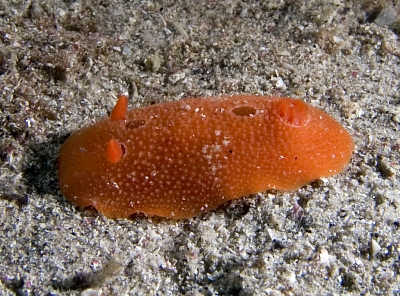
Concerning message #20297:
Hello Bill,
Found this Aldisa sanguinea in the sand at Hopkins Deep Reef in Monterey, Calif. It was in sand at a depth of about 20 m. Length was something less than an inch. This is the first time I've seen this species.
Locality: Hopkins Deep Reef; Monterey, 66 feet (20 Meters), California, USA, Monterey Bay, Pacific Ocean, 14 March 2009, Sand channel between boulders. Length: 20 mm (approx). Photographer: John K.Yasaki.
John Yasaki
jyasaki@clpccd.cc.ca.us
Yasaki, J.K., 2009 (Mar 31) Aldisa sanguinea from Monterey, California. [Message in] Sea Slug Forum. Australian Museum, Sydney. Available from http://www.seaslugforum.net/find/22339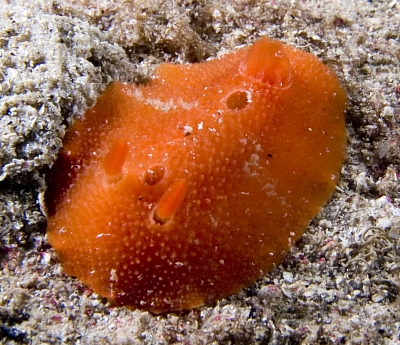
Thanks John,
Best wishes,
Bill Rudman
Aldisa sanguinea from California
July 28, 2007
From: Clinton Bauder
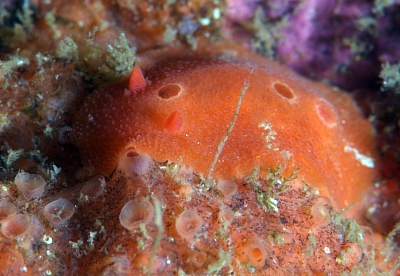
Hi Bill,
Found this Aldisa sanguinea on a funny looking red sponge that I don't recall seeing before. Certainly the spots on the back of the slug make sense in this context.
I'm not sure if the eggs belong to the Aldisa but they do look like the egg mass in message #15161.
Locality: Partington Canyon, 10 meters, CA, USA, Pacific, 21 July 2007, Rocky Reef. Length: 20 mm. Photographer: Clinton Bauder.
Clinton Bauder
gecko1@apple.com
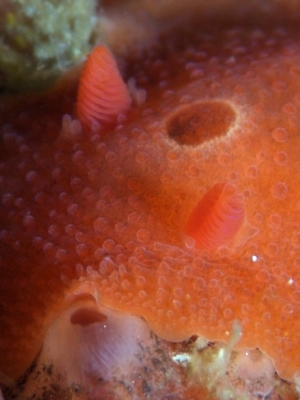
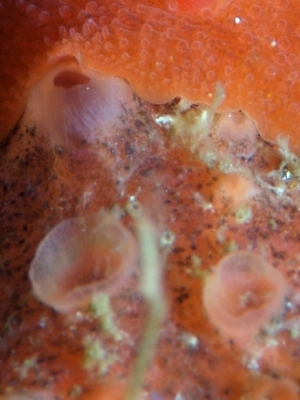
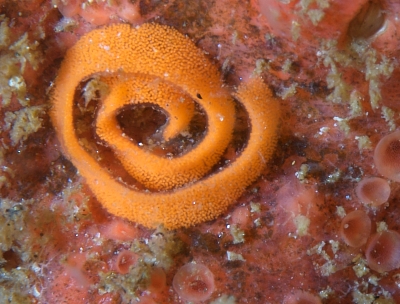
Hi Clinton,
What a perfect example of this species. Bill's close-ups show the texture of the mantle well. Note the notal tubercles are smooth, not caryophyllidic.
As far as the eggs are concerned, they certainly look like those of Aldisa. The sponge I can't help you with.
Thanks for sharing,
Dave Behrens
Aldisa sanguinea from Point Lobos, California
May 3, 2007
From: Clinton Bauder
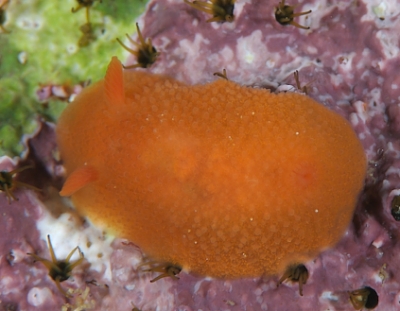
More from Point Lobos.
Pretty sure this one is Aldisa sanguinea, despite the lack of spots on its back. It's very small - maybe 6 or 7mm. When I first saw it I figured it was Rostanga pulchra but after checking the focus on my first shot I realized the rhinophores weren't right for Rostang a.
Locality: Point Lobos State Reserve, 17 meters, California, USA, Pacific, 4 March 2007, Rocky Reef. Length: 6-7 mm. Photographer: Clinton Bauder.
Cheers,
Clinton
gecko1@apple.com
Bauder, C., 2007 (May 3) Aldisa sanguinea from Point Lobos, California. [Message in] Sea Slug Forum. Australian Museum, Sydney. Available from http://www.seaslugforum.net/find/19611Hi Clinton,
This is an interesting specimen. Just shows us how much variation can exist within a species.
Thanks for sharing,
Dave Behrens
Aldisa sanguinea from Carmel, California
April 27, 2006
From: Clinton Bauder
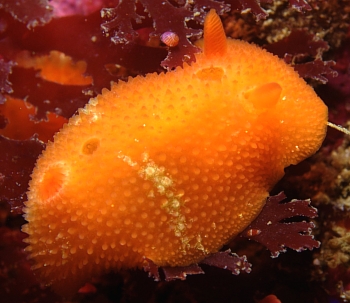
Hi Bill,
Had a good day of branching at Point Lobos recently, as we found 19 different species. This is Aldisa sanguinea which is relatively rare. Interesting that it didn't appear to be on a food sponge or anywhere near one. The picture is by my friend Mark Lloyd.
Locality: Point Lobos State Reserve, 10 meters, CA, USA, Pacific, 15 April 2006, Rocky Reef. Length: 50mm. Photographer: Mark Lloyd.
Clinton
gecko1@apple.com
Bauder, C., 2006 (Apr 27) Aldisa sanguinea from Carmel, California. [Message in] Sea Slug Forum. Australian Museum, Sydney. Available from http://www.seaslugforum.net/find/16381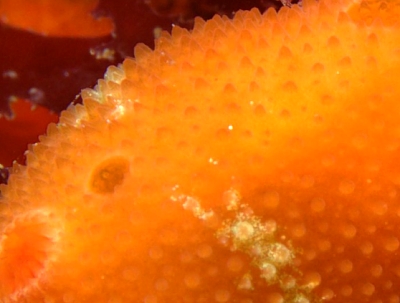
Hi Clinton,
Nice find and great photo. You are correct on the ID. No other species on this coast has the characteristic conical gill and the two round dorsal spots. The occurence of the white saddle anterior to the gill is variable among specimens, as is the ground color which varies from deep red to your yellow orange shown here. Bill's cropped shot (right) clearly shows the shape of the dorsal tubercles in this species.
Thanks,
Dave Behrens
Re: Aldisa sanguinea from British Columbia
November 5, 2005
From: Brian K. Penney
Bill-
I can confirm that I also saw forms like Marli photographed [message #15161] in my time at Bamfield (on the west coast of Vancouver Island, about one degree south and west of Campbell River). As Jeff indicated in his message [#15173], we can be sure they are not Rostanga pulchra because the dorsal surface is covered with papillae rather than caryophyllidia. I also have no records of collecting Rostanga that were 20 mm long (most were 15 mm or under) or that deep: I always saw them at 3m or less depth.
At Bamfield I found Aldisa cooperi at 10-12 m, but they always were yellow to cadmium orange, never to carrot orange or darker, and I always remember them having spots, though my sample size is less than ten.
The two individuals I have in my notes that match Marli's specimen were 11 and 12 mm respectively, and collected at Scott's Bay, Barkley Sound at a depth of 3-4m in November of 1998. They were approximately the shade of orange in the photograph and lacked dorsal spots or depressions.
Locality: Scott's Bay, Barkley Sound (48º50'06"N, 125º08'48"W). British Columbia, Canada. Pacific Ocean. Depth: 3-4 m. Length: 11 and 12 mm. 9 November 1998. Subtidal, semi-protected boulder/bedrock in kelp bed
Hope that's not too excessive detail.
Cheers,
Brian
bpenney@anselm.edu
Penney, B.K., 2005 (Nov 5) Re: Aldisa sanguinea from British Columbia. [Message in] Sea Slug Forum. Australian Museum, Sydney. Available from http://www.seaslugforum.net/find/15177Dear Brian,
Thanks for this. It's certainly not too much information and I suspect confirms my suspicion that the animal in Marli's message I am posting today [#15178] is Aldisa cooperi rather than Rostanga.
Best wishes,
Bill Rudman
Aldisa sanguinea from British Columbia
November 4, 2005
From: Marli Wakeling
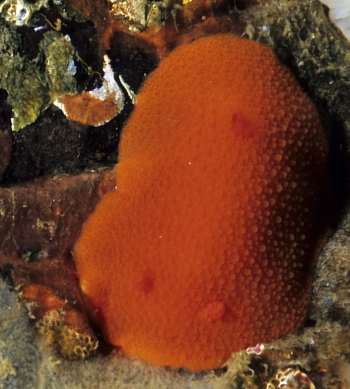
Hi Bill,
Found this Aldisa sanguinea with an egg ribbon, and perhaps its food sponge when visiting Campbell River last month; it's always a great locale for interesting nudibranchs.
Locality: Campbell River, British Columbia, Canada, Pacific coast. Depth: 40 feet. Length: 20 mm. 09 October 2005. Rock wall. Photographer: Marli Wakeling
Cheers,
Marli
scubamarli@gmail.com
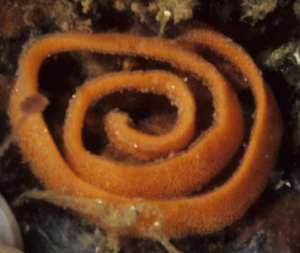
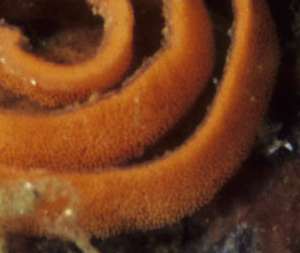
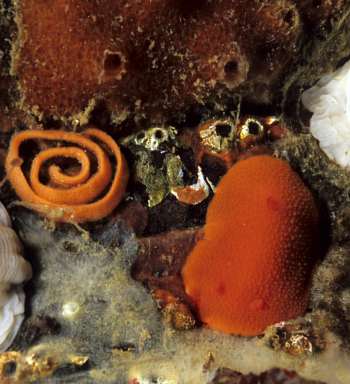
Dear Marli,
The photo well illustrates the dangers of identifying food sponges. I guess the food of this animal is not the two obvious sponges - the blue-grey one at the bottom, or the brownish one at the top, but the red one the slug is actually sitting on and appears to have eaten most of, except for a bit just above the slug around two barnacles.
I would like some guidance from west coast experts please on the identity of this slug. I thought A. sanguinea usually 2 or 3 large dark spots in the dorsal midline, and the other Aldisa, A. cooperi, had a series of little dark spots in the midline. The gills and rhinophores don't give many clues as I can't see any detail, but is it possible this is Rostanga pulchra? Hopefully the nice egg ribbon will give someone familiar with the fauna a clue.
Best wishes,
Bill Rudman
Re: Aldisa sanguinea from British Columbia
November 4, 2005
From: Jeff Goddard
Hi Bill,
Marli's specimen [message #15161] is unquestionably Aldisa sanguinea and represents a significant range extension from the previous northernmost locality in Oregon. The dorsal papillae are broader and more widely spaced than in Rostanga pulchra, and the egg ribbon is characteristic and not at all like the tightly coiled string of Rostanga. Aldisa sanguinea usually has two dark spots on the midline of the dorsum, but one or both may be absent. I have seen a number of specimens in Oregon just like Marli's.
You are also quite correct in your supposition about the sponge prey of Marli's specimen. Although I only have food records for three individuals, they were all on a red, thinly encrusting species of Hymedesmia.
Best wishes,
Jeff
goddard@lifesci.ucsb.edu
Goddard, J.H.R., 2005 (Nov 4) Re: Aldisa sanguinea from British Columbia. [Message in] Sea Slug Forum. Australian Museum, Sydney. Available from http://www.seaslugforum.net/find/15173Dear Jeff,
Thanks for the quick response. Not trying to be tricky or anything but can you get Aldisa cooperi with no black spots, and if so is there any way to distinguish it from an A. sanguinea like this externally?
Best wishes,
Bill Rudman
Aldisa sanguinea, a fairly uncommon nudibranch
August 8, 2003
From: Bruce Wight
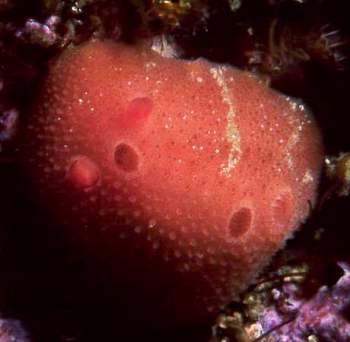
Dear Bill,
Johanna and I saw lots of great natural behavior on last weekends dive trip out to San Miguel Island [Channel Islands National Park, California - July 2003]. Here is one of a series of messages showing some images I took during the two day trip.
This photo is of a specimen of Aldisa sanguinea a fairly uncommon nudibranch.
Best wishes,
Bruce Wight
bwproductions@earthlink.net
Wight, B., 2003 (Aug 8) Aldisa sanguinea, a fairly uncommon nudibranch. [Message in] Sea Slug Forum. Australian Museum, Sydney. Available from http://www.seaslugforum.net/find/10651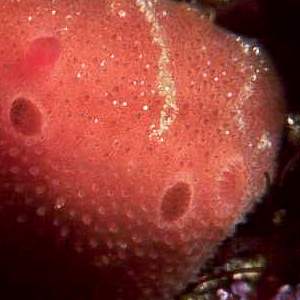
Thanks Bruce,
I have included a close-up alongside to show the very characteristic dark spots found in the dirsal midline of many species of Aldisa. They are usually outlined in a lighter colour and seem to be an attempt to mimic the oscula or common siphons found in many large sponge colonies.
Best wishes,
Bill Rudman
Aldisa sanguinea from Carmel, CA
February 20, 2002
From: Clinton Bauder

Hi Bill,
One more for the Forum. This is Aldisa sanguinea. I found this animal at a depth of about 10m at North Monastery Beach in Carmel, California. It is about 25mm long.
Clinton
gecko1@apple.com
Bauder, C., 2002 (Feb 20) Aldisa sanguinea from Carmel, CA. [Message in] Sea Slug Forum. Australian Museum, Sydney. Available from http://www.seaslugforum.net/find/6177Thanks Clinton,
There appear to be three spots on this animal but I guess the most posterior one is in fact the gill pouch opening.
Bill Rudman
